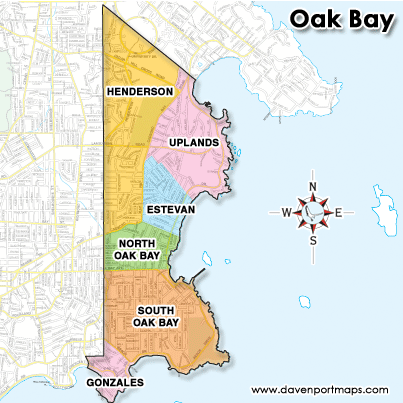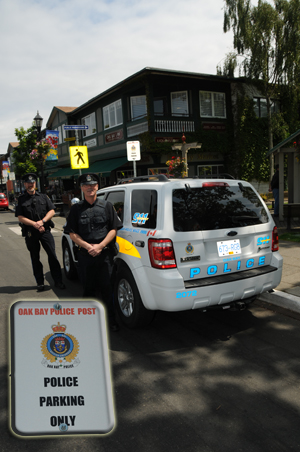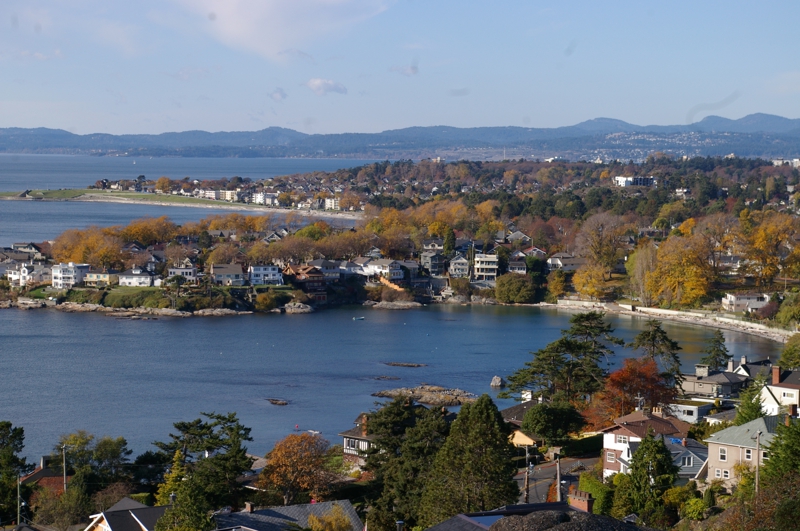Policing the Land of Millionaires
Photo (Web). Aerial view looking south over Oak Bay towards the Strait of Juan de Fuca and the Olympic Mountains in Washington State.
Over the century since incorporation, the Municipality of Oak Bay gained a reputation as having more millionaires per capita than any other city or town in Canada. Whether that is true or not, the Municipality certainly exudes a sense of affluence and boasts some of the  most pristine waterfront of any city or town in the country.
most pristine waterfront of any city or town in the country.
Stately Gary Oaks line the streets, quaint shops dot Oak Bay Avenue and citizens are provided access to some of the best recreation and senior citizen programs in the city. The list of benefits is nearly endless and each is highly valued by the 18,000 residents that call Oak Bay home.
Situated on the extreme south-eastern tip of Vancouver Island, Oak Bay has year-round mild weather – a location where flowers bloom winter long, and where, with only the occasional exception, golfers hit the links every month of the year. ‘Tea and crumpets’ holds top billing at Starbucks, but sadly, for the police members, Tim Horton’s has not yet broken into the yuppie market that defines Oak Bay.
As most of the land base in Oak Bay was almost fully developed by the middle of the last century, the population has remained fairly static at an estimated 16,000 in the 1960s (when I began policing) to little more than 18,000 today – not exactly exponential growth.
Most of that small increase was due to replacing residential properties with apartment buildings or rezoning other properties to multiple family dwellings. As has the population has remained fairly stable, so to has the number of sworn police officers – expanding from 16 in 1960s, to 24 in 2010.
 Affluent or not, the citizens of Oak Bay and their small police force have faced and continue to face many of the same problems faced by most cities and towns across Canada as demonstrated by the world-wide attention given to one recent, particularly horrendous, crime. It was only a few decades early that Constable Al Campbell and I investigated another murder only a few hundred feet from the scene of that crime.
Affluent or not, the citizens of Oak Bay and their small police force have faced and continue to face many of the same problems faced by most cities and towns across Canada as demonstrated by the world-wide attention given to one recent, particularly horrendous, crime. It was only a few decades early that Constable Al Campbell and I investigated another murder only a few hundred feet from the scene of that crime.
In Oak Bay, property crimes such as Break, Enter and Theft, from 1960 through to the late 1980s (a time of rapidly increasng crime rates) were likely as high as, or higher than, many similar sized communities. Neither did affluence act as a barrier to family breakdown, youthful misadventure or a myriad of other non-criminal matters into which police are regularly drawn.
By way of comparison to Victoria – if one removed most of the late evening street rowdiness following bar closures and other disruptive street behaviours typical of a busy downtown core, Victoria Police would be left dealing with calls very similar to those experienced throughout the region.
As you will see when reading the stories in this series, Oak Bay Officers were afforded a unique opportunity to become deeply involved in all aspects of policing. While police members in larger forces tend to specialize (e.g. traffic, general patrol, fraud, detective office, records, fraud, identification section, etc.), members in smaller municipal forces, by necessity, must become ‘generalists’ and, with as few as two or three members per shift, responsible for every type of call that might arise during a shift, a situation not dissimilar to that experienced in hundreds of smaller communities across Canada.
As generalists, most Oak Bay officers, at one time or another, were required to investigate from beginning to end, criminal offences including murder, rape, abduction, drug trafficking and cultivation, assault, criminal negligence, impaired driver and a variety of other serious crimes. As well, every officer was simultaneously responsible for all traffic matters up to and including fatalities.
No member of the department, including the Chief Constable, Deputy Chief and NOCs, were off the call list when needed, therefore every officer had to acquire and maintain a wide range of policing skills as well as become regularly involved community policing strategies. No one could sit back and assume that someone else would take on specialized investigation such as fraud, historical sexual assault, etc..
However, the overwhelming advantage of having their own police, as is the case in many smaller communities that employ their own “home grown” force, was the close relationship developed between the police and the citizens paying for that service. Regular contact with the Mayor, Council, Police Board members, businessmen and woman and other citizens, by all ranks within the department, insured there was no sense that any police member or citizen was just a small cog in a big wheel. Each member of the police force, within the limits of rank, could significantly affect policing outcomes and all persons could be guaranteed direct access to department members, up to and including the Chief Constable.
Community Policing
Community Policing, as practiced in Oak Bay, Central Saanich, Saanich and, until a few years back, in Esquimalt, is an aspect of policing that in larger cities is difficult to accomplish. This is  not because officers in the larger cities are over-burdened, but related more to an organizational structure that takes many officers away from the street and assigns them to law enforcement pockets or career specializations from which they seldom deign to stray.
not because officers in the larger cities are over-burdened, but related more to an organizational structure that takes many officers away from the street and assigns them to law enforcement pockets or career specializations from which they seldom deign to stray.
As a result those officers are usually unable or, more likely, unwilling to attend anything but the most serious calls outside their specialty field. Community policing is left to a few officers assigned to that specific task.
Within the Capital Region, Victoria police officers are particularly susceptible this policing challenge. This may be due, in part, because they have come to believe their own press releases about how overburdened they are and in part, because the Victoria media has often seized upon occasional regional policing challenges, to beat the drum of amalgamation.
Strangely, amalgamation has seldom, if ever, been discussed in terms of folding Victoria and the twelve municipal governments into one political entity; only the police that have been singled out for that distinct honour.
While amalgamation of the police may provide a few benefits, the loss of a community based service in Oak Bay, Saanich and Central Saanich would be significant. This is no better demonstrated than with Esquimalt experience since having opted to contract their police service to the City of Victoria.
For those policed by the RCMP in Sidney, North Saanich and the West Shore, continuous turnover of personnel is an ongoing reality. With administrative systems based in a remote HQ, accountability at the local or even provincial level, as noted in dozens of high profile cases over the past several years, is almost negligible. This is not the least bit surprising as the RCMP structure is much better suited to federal police work than for policing cities and towns.
The relative merits of amalgamating area police forces or the full amalgamation of all local governments in the region, is discussed in the next post.
Harold McNeill
September 2011
(1695)
Trackback from your site.

